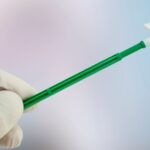The number of self-collection tests has grown 13-fold since eligibility was expanded.
The number of cervical self-screening tests has boomed since eligibility was expanded a year ago, the latest Medicare data shows.
Figures from Medicare show that nationally, the number of self-collection specimens from asymptomatic people aged 30 and over increased from 996 in June 2022 to 13,334 in April this year.
The increase was particularly steep in the ACT, where the number of self-collected tests processed by Medicare grew from just three in June last year to 142 in April this year. In South Australia, the number rose from 48 to 1199 in the same period.
Eligibility for self-screening expanded on 1 July last year to include all people with a cervix between 25 and 74 who have been sexually active, not only those who have never been screened or are under-screened.
Public health physician and epidemiologist Professor Julia Brotherton said the MBS claims data showed an increased proportion of self-collected tests across all age groups, with the highest uptake among the oldest women.
“This may reflect the discomfort many people experience with a speculum examination post-menopause,” said Professor Brotherton, professor of cancer prevention policy and implementation at the University of Melbourne.
Professor Brotherton said the highest rates of uptake were in the Northern Territory, Tasmania and South Australia, while the lowest rates were in the ACT and NSW.
“This suggests there is a difference in practice occurring across the country in the promotion and acceptance of self-collection as a screening method amongst practitioners.”
Professor Brotherton said self-collection was as accurate as provider collection for the detection of underlying CIN2 and 3+ and many people found it more comfortable.
The main disadvantage was the need to return for cytology for patients who test HPV non-16/18 positive, she said.
“The main barriers in accepting self-collection amongst patients are fear they may do the test incorrectly and concern the test is not as accurate, both concerns that can be allayed with available resources and support.
“Overall self-collection is highly acceptable to patients across the socioeconomic spectrum and our research and that of others in Australia and internationally shows it is acceptable across culturally diverse groups.”
Data also showed that self-collection is successfully engaging Aboriginal and Torres Strait Islander people and people in remote areas, Professor Brotherton said.
A spokesperson for the Department of Health and Aged Care said the increase in the proportion of self-collection was highest in very remote areas.
There has also been an increase in self-collection among people who have never been screened or were under-screened, the spokesperson said. The proportion of never-screened people using self-collection increased from 13% last year to 20% this year, while the proportion of under-screened people choosing the option increased from 14% in Q3 last year to 25% in Q1 this year.
“Not all practices have actively taken up the new option and we are encouraging them to speak with their pathology providers about setting up the process,” the spokesperson said.
“Unfortunately, there are also some misinformation about the accuracy of self-collection, but a self-collected CST sample is just as accurate at detecting HPV as a doctor-collected CST sample.”
A spokesperson for the Australian Centre for the Prevention of Cervical Cancer said data from VCS Pathology showed that the number of self-collected cervical screening tests increased 20-fold from March-May 2022, when compared with March-May 2023.
“Now that the barrier of a pelvic exam has been removed with the self-collection option, we expect that people who have never been screened will take up this option if their clinician offers it to them,” the spokesperson said.
“A pilot study demonstrated that 85.7% of never-screened or under-screened women and people with a cervix who declined a speculum examination agreed to HPV self-collection when the test was offered to them in a sensitive and culturally appropriate manner and with appropriate follow-up advice.
“More and more clinicians are now embracing the evidence that the self-collected HPV option is just as accurate as a clinician-collected sample. We believe that uptake of the self-collection option will continue to rise, with increased awareness and confidence in self-collection from both practitioners and patients.”
The updated 2021 guidelines said the option of self-collection could reduce barriers to cervical screening for under-screened and never-screened groups such as rural and remote communities, people from diverse cultural and faith backgrounds, and LGBTQIA+ communities.
It was important that health professionals communicate the meaning of HPV test results in a sensitive and culturally appropriate manner, the guidelines said.
In 2021, the Medical Services Advisory Committee (MSAC) concluded that HPV testing using self-collected samples was just as accurate as clinician-collected samples – as long as a PCR-based assay was used – and supported expanding access to self-collection to include everyone eligible for cervical screening.
Self-collection was safe and effective and would likely increase participation in cervical screening, particularly for people who may feel uncomfortable with a clinician collecting their sample, MSAC said.
An earlier version of this article incorrectly referred to “at-home” testing. It has since been updated to state these were self-collect tests. TMR regrets the error.





